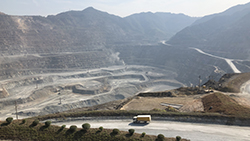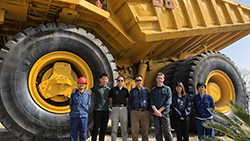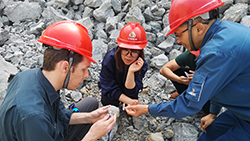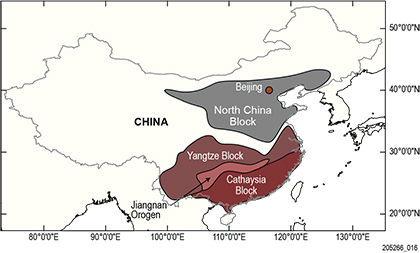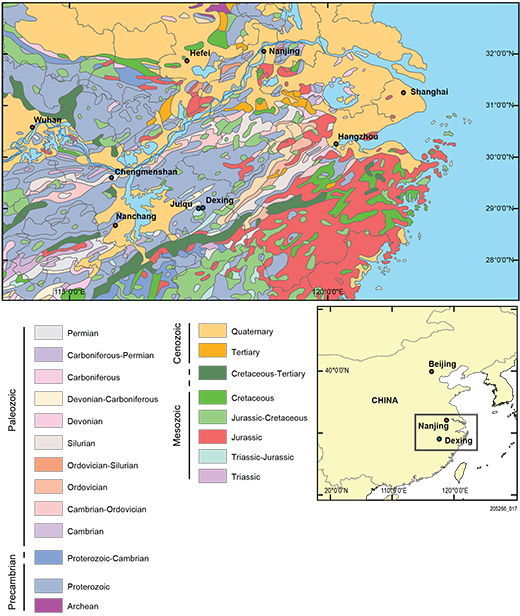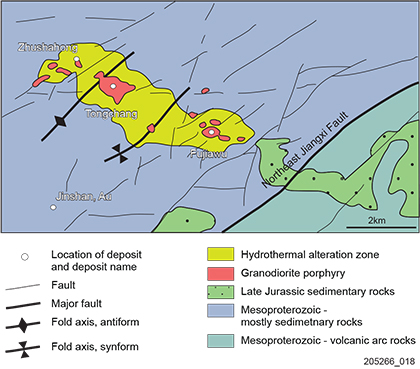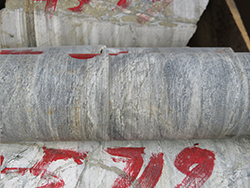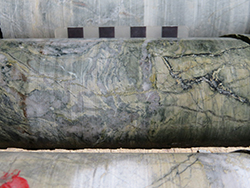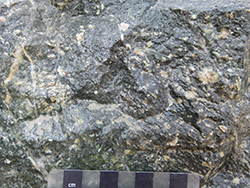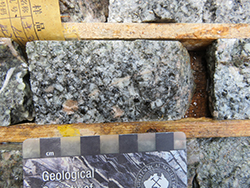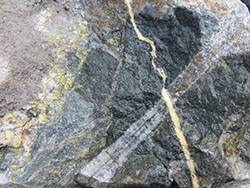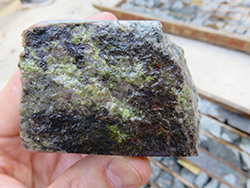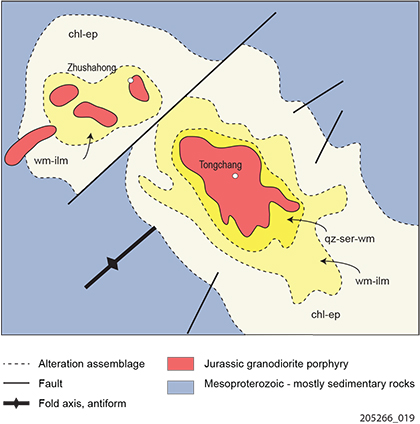Anthony Reid1, Zhao Yuhao2, Zhao Xiaodan2, Baohong Hou1 and Yao Zhongyou2
1 Geological Survey of South Australia, Department for Energy and Mining
2 Nanjing Center, Geological Survey of China
Download this article as a PDF (4.7 MB); cite as MESA Journal 93, pages 47–53
Published October 2020
Introduction
The Dexing porphyry copper–gold deposit is one of the largest copper resources in China. While there has been discovery of larger Cu–Mo–Au deposits in the Tibetan region in the past decade such as the Tiegelongnan deposit (Lin et al. 2017), Dexing is notable for the high copper grade (>1%). The deposit contains 9.7086 million tonnes (Mt) Cu, 0.4246 Mt Mo, 265.493 t Au and 1,307.20 t Ag (Zhu et al. 1983; Li and Sasaki 2007; Liu et al. 2012; Yang et al. 2015). The ore deposit formed at 170 Ma, Middle Jurassic, and is related to the widespread arc and back-arc magmatism in eastern China along the western Pacific rim (Zhou et al. 2012). The Dexing orebody formed as a result of intrusion of multiphase, predominantly intermediate composition magmas. The mine provides employment opportunities for around 1,000 people directly and many more indirectly and operates using modern facilities such as GPS tracking on heavy plant equipment and Australian software including Micromine.
The Dexing deposit is located within northeastern Jiangxi Province where it is challenging for mineral exploration due to extensive vegetation cover in this mountainous region. Copper, gold and silver ores have been known for exploitation in this region for over 2,000 years. The currently mined Dexing orebody was discovered in the 1980s. This article presents an overview of the Dexing porphyry copper–gold deposit based on a visit to the deposit by geoscientists from the Nanjing Center, China Geological Survey, and colleagues from the Geological Survey of South Australia in October 2019 (Fig 1). As an outcome of this visit, we provide an introduction to the deposit geology including alteration and mineralisation styles and a brief reflection on the key features of this mineral system.
Figure 1 Field visit by team from Nanjing Center, China Geological Survey, and Geological Survey of South Australia to the Dexing porphyry copper–gold deposit.
Photo 418093
Photo 418094
Photo 418095
Regional geology of southeastern China
Southeastern China comprises two major tectonic units, the Yangtze Craton and Cathaysia Block that were amalgamated during collision along the Jiangshao Suture Zone (Li 2013; Hu et al. 2017). The Yangtze Craton comprises late Archean and Paleoproterozoic units with ages from 2.70 to 2.60 Ga, 2.55 to 2.4 Ga, to 2.05 to 1.90 Ga (Liu et al. 2008). Neoproterozoic sedimentary and volcanic rocks, ranging from 910 to 720 Ma, are also present in the Yangtze Craton together with widespread Neoproterozoic intrusive rocks (Zhou et al. 2002; Zhou et al. 2014). These sequences are overlain by Cambrian to Triassic marine sedimentary successions and Jurassic and Cretaceous to Cenozoic continental sedimentary rocks.
The Cathaysia Block is dominated by a basement of 1.9 to 1.8 Ga sedimentary rocks and Neoproterozoic to early Paleozoic metamorphic rocks that were emplaced by widespread 480 to 400 Ma granitic intrusions (Shu et al. 2015). The Cathaysia Block comprises a series of Mesozoic intrusive complexes, with major pulses of magmatism occurring between 250 to 200 Ma, 160 to 150 Ma and 120 to 85 Ma (Hu et al. 2017). A final phase of Cretaceous to Cenozoic magmas were emplaced at 83 to 38 Ma (Chen, Lee and Shinjo 2016). A wide variety of hydrothermal mineral systems were developed in association with the Mesozoic magmatism across the Cathaysia Block, including significant tin–tungsten and base metal mineralisation (Hu et al. 2017).
Between the Yangtze Craton and Cathaysia Block lies the Jiangnan Orogen (Fig 2). The Jiangnan Orogen consists of early Neoproterozoic (1000 to 825 Ma) volcanic arc assemblages intercalated with sedimentary units of broadly similar age (Zhao 2015), together with a series of I-type and S-type granite suites (Fig 3; Yao et al. 2019). The Jiangnan Orogen records the accretion of trench-arc assemblages to the Cathaysia Block, and the final suturing of the Yangtze Craton with Cathaysia (Yao et al. 2019). The Jiangnan Orogen is characterised by a series of Mesozoic intrusions, which are related to many economically important tin–tungsten–molybdenum and copper–gold deposits (eg Zhou et al. 2012; Huang et al. 2016).
Within the Jiangnan Orogen, the Dexing porphyry copper–gold deposit occurs within Neoproterozoic metasedimentary rocks of the Zhangcunyan Group (Zhou et al. 2012). The Zhangcunyan Group is incorporated into the fold-thrust belt of the Jiangnan Orogen, being complexly folded and faulted (Yao et al. 2019). Stratigraphically above the Zhangcunyan Group are a sequence of Cambrian to Devonian sandstone, mudstone, shale, limestone and minor conglomeratic units. Mesozoic redbed sandstones occur in isolated basins across the region. These basins likely formed in response to extension during active margin tectonic processes to the east during formation of the Cathaysian Orogen.
Figure 3 Geological setting of the Dexing porphyry copper–gold deposit, compiled using additional data from the United States Geological Survey, https://catalog.data.gov/dataset/generalized-geology-of-the-far-east-geo3al.
Geology of the Dexing porphyry copper–gold deposit
Porphyritic intrusions into the Zhangcunyan Group occur as subvertical stocks and dykes, and the main copper–gold orebodies precipitate on the contacts between the intrusions and the wall rocks. The Dexing porphyry copper–gold deposit comprises three main orebodies, the Fujiawu, Tongchang and Zhushahong, of which the central Tongchang orebody is the largest (Fig 4). The orebodies have a trend to the northwest, broadly orthogonal to the regional strike of the Shuanqiaoshan Group and related units of the Jiangnan Orogen. We note that regional maps of the Dexing area also delineate a series of orogen normal or oblique structures throughout the district. Observation of slickenfibres on fault surfaces in the Tongchang pit are shallowly plunging on relatively steep fault planes, suggesting that at least one phase of deformation in the area involved a component of strike-slip movement.
Drill cores that truncate host rocks adjacent to the main orebody at Tongchang reveal that the Zhangcunyan Group comprises fine-grained, grey-coloured, weakly bedded marl, with minor carbonate and argillaceous mudstone (Fig 5a). These sedimentary rocks are faulted, brecciated and cut by quartz veins. Pyrite occurs as veinlets and is locally disseminated through these rocks (Fig 5b), with an increasing abundance proximal to the mineralised ore centre.
The mineralisation is typically veined and disseminated copper sulfides dominated by chalcopyrite and minor chalcocite and bornite. Pyrite is abundant within the deposit, occurs as massive and disseminated textures, and is intimately associated with quartz veining. Pyrite abundance varies across the deposit from an inner core of massive pyrite to an outer shell of disseminated pyrite. Molybdenite, sphalerite and galena are locally present within the deposit, with zinc and lead sulfides occurring distally to the main copper–gold orebodies.
In the Tongchang pit, we observed that an altered porphyritic granodiorite has feldspar phenocrysts up to 0.8 cm in diameter (Fig 5c). A coarser grained granodiorite was also observed in drill core, indicating that multiple intrusive phases occurred in the deposit (Fig 5d). The porphyritic granodiorite is associated with a fine-grained mafic phase, likely basaltic in composition (Fig 5e). Contact textures between this mafic phase and the granodiorite were not observed; however, microgranular mafic enclaves or broadly synchronous mafic intrusions are present within the porphyry system.
The porphyritic intrusions at Dexing have been dated at 171.0 ± 0.84 Ma, 170.2 ± 0.88 Ma and 170.7 ± 0.84 Ma (Zhou et al. 2012). Re–Os dating of molybdenite from the deposit yields a virtually indistinguishable age of 172.3 ± 2.3 Ma, supporting the temporal correlation between mineralisation and magmatism (Zhou et al. 2012). The granodiorite porphyry has a calc‐alkaline affinity, medium K2O content (1.94–2.07 wt%), and low K2O/(Na2O + K2O) (0.33–0.84) ratios (Li and Sasaki 2007; Liu et al. 2012). The Dexing porphyry intrusions are enriched in large‐ion lithophile and light rare earth elements and depleted in low high‐field‐strength elements, with a moderate to weak Eu anomaly (Li and Sasaki 2007; Zhou et al. 2012).
Figure 5 Photographs of the Dexing porphyry copper–gold deposit.
5(a) Example of sheared metasedimentary unit of the Zhangcunyan Group in drill core distal to the Dexing porphyry system. Photo 418096
5(b) Intensely fractured metasedimentary rock with pyrite-rich veinlets. Photo 418097
5(c) Sericite-altered porphyritic granodiorite observed in the Tongchang pit. Photo 418098
5(d) Medium- to coarse-grained granodiorite observed in the Tongchang pit. Photo 418099
5(e) Dark mafic micro-enclaves with possible basaltic composition cut by quartz–pyrite–molybdenite vein and a late stage calcite vein observed in the Tongchang pit. Photo 418100
5(f) Intense epidote–quartz alteration and chalcopyrite within the granodiorite from drill core. Photo 418101
All three orebodies at Dexing preserve intense hydrothermal alteration patterns that are broadly similar to those of typical porphyry copper–gold– molybdenum deposits, locally with a few variations (Fig 6). From the distal to the core of the deposit as shown in plan view (Fig 6), the alteration mineralogy includes: a distal propylitic zone comprising chlorite, epidote and carbonate; an argillic zone of quartz, sericite and kaolinite; a phyllic zone of quartz, sericite and pyrite; an inner potassic altered zone of K-feldspar, biotite and quartz; and an inner core zone of quartz, sericite and chlorite with only minor pyrite, which is likely a product of phyllic alteration that has overprinted the K-feldspar and biotite of the inner potassic zone. Our observations both in the Tongchang pit and in drill cores that cut through the high-grade copper mineralisation at Tongchang confirm the mapping data. The porphyritic granitoid is pervasively phyllic and sericite altered and feldspar phenocrysts are replaced by a green platy mineral, likely epidote. Magnetite is present with the biotite–chlorite–epidote assemblage in places and intense chlorite alteration is evident in the propylitic zone. Pyrite and chalcopyrite are disseminated throughout laterally from the potassic core to the phyllic zone.
Key features of the Dexing porphyry copper–gold deposit
There are several key features of the Dexing porphyry copper–gold deposit that are illustrative of porphyry systems generally including:
- Multiple phases of high-level porphyritic intrusions with intermediate to felsic compositions.
- Normal structural control on emplacement of porphyritic stocks, within a possible strike-slip deformation regime.
- Adjacent to an existing metal accumulation province.
- Characteristic alteration zonations around the deposit from the distal propylitic, intermediate phyllic to the potassic alteration (eg Sillitoe 2010).
At a regional scale the deposit is located near a major tectonic boundary, and mineralised magmas were derived from melting of modified mantle due to subduction (Liu et al. 2012). Interestingly, some workers consider the porphyritic intrusions of Dexing to have formed in an intracontinental, or back-arc setting, rather than from melting of a mantle wedge directly above a subduction zone (Liu et al. 2012). In this model, a pre-existing metasomatised mantle was the source for the enriched magmas which formed as a result of back-arc extension during the Mesozoic.
Some implications for the Delamerian Orogen, South Australia
The Delamerian Orogen formed in a broadly arc to back-arc setting at the eastern margin of Gondwana during the Cambro-Ordovician (Foden et al. 2006; Foden et al. 2020). The orogen therefore represents a broadly similar tectonic setting to that of the Cathaysian Orogen, in that it is also a region on the western paleo-Pacific rim. High-level granitic to diorite intrusions occur within the Delamerian Orogen, forming both early in the deformation history and as late stage intrusions. There are extensive intrusive suites that intrude the Cambrian Kanmantoo Group, but also examples of intrusions into Neoproterozoic rocks of the Adelaide Rift Complex, such as the Anabama Granite. The Anabama Granite is associated with copper–molybdenite mineralisation, although not at economic grades from current drilling. This and other granite and granodiorite intrusive complexes of the region may be broadly similar, though not identical, porphyry-type intrusive systems as those at the Dexing deposit.
Changes in strike along the length of the Delamerian Orogen provide a structural setting in which lateral displacement may be accommodated by structures that lie perpendicular or near perpendicular to the overall orogenic trend. Potentially, such cross structures could have focused fluid and magmas from deeper crustal levels.
Further work is required to understand the tectonic setting of the Delamerian magmatic systems, to define their mineral potential and to understand their crustal-scale architecture in relationship to the orogen. We note that current work programs of the Geological Survey of South Australia associated with MinEx Cooperative Research Centre will address some of the knowledge and data gaps for the Delamerian Orogen.
Conclusion
The Dexing porphyry copper–gold–molybdenum mine is one of Asia’s largest copper deposits. Geological features of the deposit, including magmatic composition, alteration zonation and regional tectonic setting are similar to many other porphyry deposits. The mineralised hydrothermal systems of this deposit were likely to develop in a back-arc or intracontinental setting. Knowing these features can help with exploration for economical-grade porphyry deposits in the Delamerian Orogen of South Australia.
Acknowledgements
We thank colleagues at the Jangxi Mineral Resources Bureau, in particular Zeng Zhiyong and Pan Qin, for facilitating our visit to the Dexing region and the Dexing and Jinshan deposits. We also thank geologists of the Dexing mine, in particular Mr Yue, for their introduction to the deposit. This paper is a contribution arising from a collaborative memorandum of understanding between Nanjing Center, China Geological Survey, and Geological Survey of South Australia, first signed in 2014 and renewed in 2017 for a further three years. We appreciate the thorough review of this paper by Dr Wei Hong, University of Adelaide.
References
Chen C-H, Lee C-Y and Shinjo R 2016. The epilog of the western paleo-Pacific subduction: inferred from spatial and temporal variations and geochemistry of the Late Cretaceous to Early Cenozoic silicic magmatism in coastal South China. Journal of Asian Earth Sciences 115:520–546. doi:10.1016/j.jseaes.2015.10.002.
Foden J, Elburg MA, Dougherty-Page J and Burt A 2006. The timing and duration of the Delamerian Orogeny: correlation with the Ross Orogen and implications for Gondwana Assembly. The Journal of Geology 114:189–210. doi:10.1086/499570.
Foden J, Elburg M, Turner S, Clark C, Blades ML, Cox G, Collins AS, Wolff K and George C 2020. Cambro-Ordovician magmatism in the Delamerian orogeny: implications for tectonic development of the southern Gondwanan margin. Gondwana Research 81:490–521. doi:10.1016/j.gr.2019.12.006.
Hu R, Fu S, Huang Y, Zhou M-F, Fu S, Zhao C, Wang Y, Bi X and Xiao J 2017. The giant South China Mesozoic low-temperature metallogenic domain: reviews and a new geodynamic model. Journal of Asian Earth Sciences 137:9–34. doi:10.1016/j.jseaes.2016.10.016.
Huang Q, Kamenetsky VS, Ehrig K, McPhie J, Kamenetsky M, Cross K, Meffre S, Agangi A, Chambefort I, Direen NG, Maas R and Apukhtina O 2016. Olivine-phyric basalt in the Mesoproterozoic Gawler silicic large igneous province, South Australia: examples at the Olympic Dam iron oxide Cu–U–Au–Ag deposit and other localities. Precambrian Research 281:185–199. doi:10.1016/j.precamres.2016.05.019.
Li X 2013. Tectonic history of the major east Asian lithospheric blocks since the Mid-Proterozoic — a synthesis. In Flower MFJ, Chung S-L, Lo C-H and Lee T-Y eds, Mantle dynamics and plate interactions in East Asia, Geodynamics Series 127, pp 221–243. doi:10.1029/GD027p0221.
Liu X, Fan H-R, Santosh M, Hu F-F, Yang K-F, Li Q-L, Yang Y-H and Liu Y 2012. Remelting of Neoproterozoic relict volcanic arcs in the Middle Jurassic: implication for the formation of the Dexing porphyry copper deposit, southeastern China. Lithos 150:85–100. doi:10.1016/j.lithos.2012.05.018.
Liu X, Gao S, Diwu C and Ling W 2008. Precambrian crustal growth of Yangtze Craton as revealed by detrital zircon studies. American Journal of Science 308:421–468. doi:10.2475/04.2008.02.
Sillitoe RH 2010. Porphyry copper systems. Economic Geology 105:3–41. doi:10.2113/gsecongeo.105.1.3.
Yang MG, Yin GS, Tang WX, Lou FS et al. 2015. Geology and mineral resources record of China, Jiangxi volume. Beijing. Geological Publishing House (in Chinese with English abstract).
Yao J, Cawood PA, Shu L and Zhao G 2019. Jiangnan Orogen, South China: a ~970–820 Ma Rodinia margin accretionary belt. Earth-Science Reviews 196:102872. doi:10.1016/j.earscirev.2019.05.016.
Zhao G 2015. Jiangnan Orogen in South China: developing from divergent double subduction. Gondwana Research 27:1173–1180. doi:10.1016/j.gr.2014.09.004.
Zhou M-F, Yan D-P, Kennedy AK, Li Y and Ding J 2002. SHRIMP U–Pb zircon geochronological and geochemical evidence for Neoproterozoic arc-magmatism along the western margin of the Yangtze Block, South China. Earth and Planetary Science Letters 196:51–67. doi:10.1016/S0012-821X(01)00595-7.
Zhou M-F, Zhao X-F, Chen WT, Li X-C, Wang W, Yan D-P and Qiu H-N 2014. Proterozoic Fe–Cu metallogeny and supercontinental cycles of the southwestern Yangtze Block, southern China and northern Vietnam. Earth-Science Reviews 139:59–82. doi:10.1016/j.earscirev.2014.08.013.
Zhou Q, Jiang Y-H, Zhao P, Liao S-Y and Jin G-D 2012. Origin of the Dexing Cu-bearing porphyries, SE China: elemental and Sr–Nd–Pb–Hf isotopic constraints. International Geology Review 54:572–592. doi:10.1080/00206814.2010.548119.
Zhu X, Hang CK, Rui ZY, Zhou YH, Zhu XJ, Hu CS and Mei ZK 1983. The geology of Dexing porphyry copper ore field. Geological Publishing House, Beijing.


